
NOW Articles Written By Members
An Argument for Collecting Half Dollars
Late Night and a Russian Type Set
Old Country Coins: Newfoundland’s Rarest 5-Cent
Milwaukee Medals: Fifth Ward Constable
A look back at a common, but classic commemorative – Wisconsin’s Territorial Centennial
A side-tracked story: Mardi Gras Doubloons
A look back at a collecting specialty – the O.P.A. ration tokens of WWII
Bullion And Coin Tax Exemption – Act Now!
Is There A Twenty Cent Piece We Can Add To A Collection
Capped Bust Half Dollars: A Numismatic Legacy
U.S. Innovation Dollars: Our Most Under-Collected Coin?
My 2023 ANA Summer Seminar Adventure
>> More articles in the Archive
For more NOW Articles Written By Members,
The 1828 Mt. Ararat Gold Medal
[by L. A. Saryan #0100L]
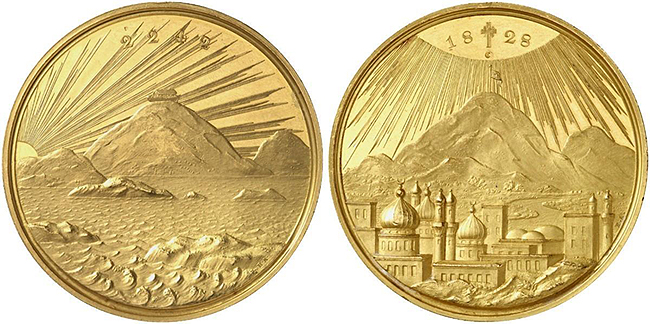
For those who might wonder about the value of Armenian numismatic collectibles, consider the results of the March 14, 2017, auction held by the venerable German firm of Fritz Kunker. Lot 2010 of Kunker auction 289 is an apparently unique solid gold medal struck in Russia to commemorate the capture of Yerevan, today the capital of the Republic of Armenia, from Persia by the armies of the Russian Czar.
Both sides of the medal depict the peaks of biblical Mt. Ararat. The obverse shows the mountain rising above the deluge, surmounted by the Ark of Noah (Genesis 8:4). According to Moscow numismatist Alex Akopyan, the date 2242 represents the year after the creation that the Ark landed on Ararat per calculations made from Vatican codexes. The opposite face shows Ararat with a flag at its peak, the date 1828 (the year that Yerevan was incorporated into the Russian Empire by the Treaty of Turkmenchay), the river Araxes flowing through a broad plain at the foot of the mountain, and in the foreground the skyline of the city of Yerevan with onion shaped domes as it existed under Persian rule. The absence of a legend does not in the least diminish the appeal of this medal; rather, it compels the numismatist to research and appreciate the medal’s historical significance.
The medal is 172.39 grams, 64.57 mm diameter and catalogued as Diakov 476.1. The engraver was V. Alexeev. Described by Kunker as being of the most extreme rarity (this is apparently a euphemism for unique), the original estimate was 50,000 Euro with a starting bid of 40,000 Euro. After obviously vigorous bidding, this gem was hammered down for an astounding 110,000 Euro ($118,100 US). According to the auctioneers, this piece was formerly in the collections of famous numismatists Emeryk Hutten-Czapski and Grand Prince Georgy Mikhailovich. The Kunker sale also appears to be the first appearance of the medal since 1939, when it was offered at an Adolph Hess auction in Lucerne, Switzerland.
Without doubt, this is one of the most attractive and historically significant medals issued by Russia in the nineteenth century. In 1826-1828, Czarist Russian forces commanded by General Ivan Paskevich captured the southern Caucasus from the Persians and incorporated the region into the Russian Empire. The defeated Persians were permanently forced south across the Araxes River. For the first time in several centuries, an important part of the Armenian homeland came under Christian control, and Paskevich was awarded the title of Count of Yerevan. Soon thereafter Czarist armies pushed westward into Ottoman territory, capturing several important cities with large Armenian populations (including Kars and Erzerum) from the Turks. The Armenians saw Russia as their savior, and many Armenians living in neighboring Persia and eastern Turkey subsequently migrated to relative safety in districts that were now under Russian control. A century later, the demographic shift in the southern Caucasus became a key factor in the reestablishment of Armenian statehood which took place in 1918.
Late in 2017, my friend Levon Vrtanesyan in New Jersey alerted me to the sale of the gold medal. I took the liberty of posting images of the medal on the Facebook page of the “Armenian Numismatic and Antiquities Society” where a most interesting discussion transpired, with experts from Moscow, Yerevan, the USA and elsewhere participating. As often happens, there is some controversy about the medal and exactly what it represents. The depiction of the peaks of Mt. Ararat on the medal is not quite accurate. The expert consensus is that the medal depicts the city of Yerevan, although when viewed from Yerevan, lesser Ararat (the smaller of the twin peaks) should appear to the left of the main peak, rather than to the right. The identity of the river in the middle field is also debated. I contend that it is the Araxes, the principal stream in this region, which flows through a broad plain at the foot of the mountain as shown on the medal, and not the Hrazdan, a smaller river that runs through a steep gorge. Since the medal was prepared in St. Petersburg, it is very possible that some geographical inaccuracies crept into the design.
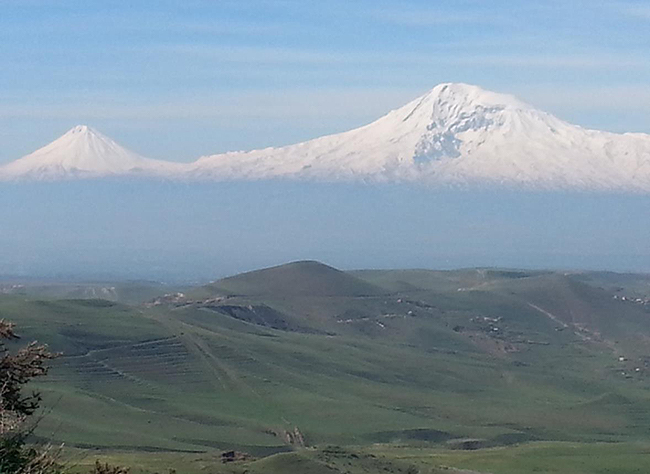
For those who travel to Armenia, the sight of Mt. Ararat when viewed from Yerevan is unforgettable. Rising to an elevation of nearly 17,000 feet, the summit of the taller peak is usually enveloped in clouds. On clear days the entire massive rock can be visualized; it rises about 3 miles from its base in the Araxes valley (which is only about 1000 feet above sea level) to the summit. On hazy days, as on April 26, 2015, when I took this photo, atmospheric conditions create the impression that the twin peaks are hanging in midair.
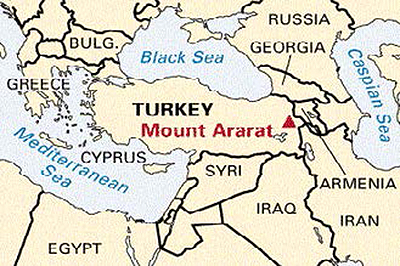
The reappearance of this extraordinary gold medal is an exciting revelation for numismatists interested in Armenian medals and the history of Armenia’s association with Russia in the nineteenth century. According to numismatist Alex Akopyan, the gold example is unique; it was struck in the weight of 50 Dutch gold ducats using the ducats as the source of the metal, and this is confirmed by its weight. There was a debate as to whether silver copies of this medal actually exist. Silver examples do exist (I recently saw a photograph of one) but they may be later restrikes. A handful of bronze examples of this medal are known, and these are occasionally available to the patient collector.
Although the gold medal was unfortunately out of my reach (!), I consider myself fortunate to own two bronze specimens depicting the exact same scene. Both examples have the same diameter and design as the gold.
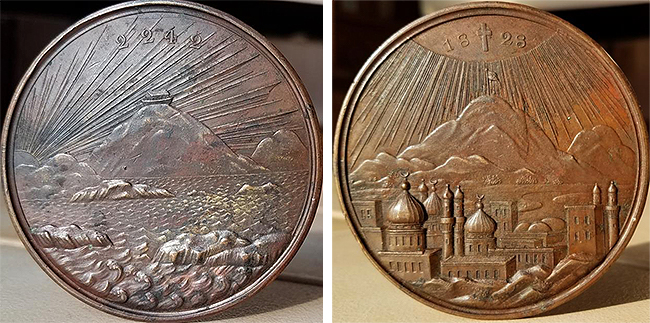
Above is the first bronze example, 122.01 grams, 64.9 mm diameter, numbered 278 on the edge, which I obtained from the late Jack Guevrekian in 2001, who in turn obtained it from dealer Paul Bosco. It has a pleasing chocolate patina and shows all the details present on the gold piece.
I am also fortunate to own another example, 73.05 grams, 64.8 mm diameter, which was apparently modified in the 19th century for display purposes. The side showing the ark and the deluge is no longer present. It appears as if that side of the medal was hollowed out, filled with pewter or lead, and a paper label affixed. Careful examination suggests that this might be half of an electrotype. The label, in neatly hand-inscribed French, is not exactly accurate as it suggests that the medal has a religious significance, and that the city view is actually the Armenian Monastery of Echmiadzin (the seat of the Supreme Patriarch of the Armenian Church, located about 15 miles west of Yerevan). I obtained this piece in 2006 from a seller in France, and I have never seen a similar example.
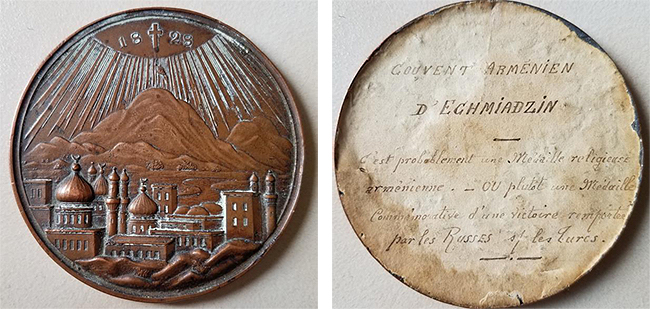
This medal is one of the most historically significant monuments of the long association between the Russian and Armenian peoples, a relationship that, despite numerous political changes over the past two centuries, endures to the present day.
Have an interesting numismatic topic you’d like to share with your fellow NOW members?
Send your article to evan.pretzer@protonmail.com today!!!